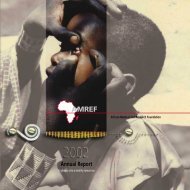Celebrating African Motherhood - Amref
Celebrating African Motherhood - Amref
Celebrating African Motherhood - Amref
Create successful ePaper yourself
Turn your PDF publications into a flip-book with our unique Google optimized e-Paper software.
Why Maternal, Neonatal and Child Health?<br />
“What women in the developed world take for granted –<br />
skilled midwives, an obstetrician and operating theatre if<br />
needed, and the antibiotics and drugs to ensure that should<br />
complications arise, the mother is rapidly brought back to<br />
good health – these apparently basic things, are regarded<br />
as a great luxury in Africa.” Dr John Nduba, AMREF Director for<br />
Sexual, Reproductive and Child Health.<br />
A woman in Africa has a one in 16 chance of dying in childbirth,<br />
compared with a woman in Europe who has a one in 30,000 chance of<br />
dying during delivery. This is the biggest health inequality in the world<br />
today.<br />
In sub-Saharan Africa 280,000 mothers a year are dying for lack of<br />
simple, aff ordable and reachable medical care. The most aff ected<br />
women and children are in the most remote and poorest places in<br />
the continent. As a result, nearly 1.5 million <strong>African</strong> children a year<br />
are left without a mother because she dies trying to give birth to a<br />
brother or sister. It also goes without saying that without a mother,<br />
this newborn baby is 10 times more likely to die within the fi rst two<br />
years of its life.<br />
In many sub-Saharan <strong>African</strong> countries the maternal death rate<br />
is unfortunately getting worse, and it is unlikely that Millennium<br />
Development Goal 5 (reducing maternal deaths by 75 per-cent by<br />
2015) will be achieved without urgent action.<br />
The direct causes of maternal deaths are bleeding, infection,<br />
obstructed labour, hypertensive disorders in pregnancy, and<br />
complications of unsafe abortion. At least 20 per cent of the burden<br />
of disease in children below the age of fi ve is related to poor maternal<br />
health and nutrition, as well as quality of care at delivery and in the<br />
post-delivery period.<br />
HIV infection is also a threat. Mother-to-child transmission of HIV in<br />
sub-Saharan Africa, where infection in adults is continuing to grow<br />
or has stabilised at very high levels, continues to be a major problem,<br />
with up to 45 per cent of HIV-infected mothers transmitting infection<br />
to their children. Further, HIV is becoming a major cause of maternal<br />
mortality in parts of Africa.<br />
A majority of these deaths are preventable, being mainly due to<br />
insuffi cient care during pregnancy and delivery. About 15 per cent of<br />
pregnancies and childbirths need emergency obstetric care because<br />
of complications that are diffi cult to predict.<br />
Access to skilled care during pregnancy, childbirth and the fi rst month<br />
after delivery is key to saving a mother’s life and that of her baby.<br />
AMREF is a leader in giving direct help to mothers and newborn<br />
babies, and we provide showcase solutions that are adopted by other<br />
organisations and governments across Africa. Over the next fi ve years<br />
we want to grow our services even further. As always our focus will<br />
be on the people who need help most: mothers and families in the<br />
places least served by health services – from people in neglected<br />
urban slums to poor and remote rural communities.<br />
It is estimated that 60 per cent of deaths in children under fi ve can be<br />
prevented, most through community-based interventions. Therefore<br />
the strengthening of community-based health workers and links to<br />
health centres will continue to be an essential element of AMREF’s<br />
activities.<br />
Dr John Nduba sums up AMREF’s vision:<br />
“I can see a future where every woman in Africa understands her body<br />
and the choices she has; a future where she chooses when she wants<br />
to have children, or even if she wants to have children; a future where<br />
she receives care during her pregnancy and birth from a trained<br />
professional, and a future where her r newb newborn is delivered healthy.<br />
In that future her baby is immunised unised shortly aafter<br />
birth and receives<br />
treatment from a trained health worker if the bab<br />
baby gets sick.”<br />
11





